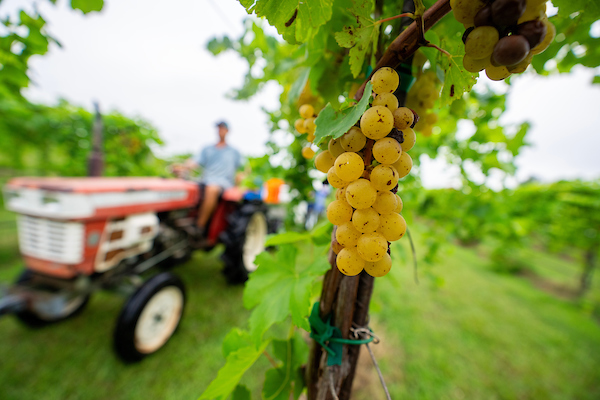Expectations are for the 2023 Texas wine grape season to produce a quality vintage despite some challenges here and there, said Texas A&M AgriLife Extension Service experts.
AgriLife Extension viticulturists located around the state, including Daniel Hillin in the Texas High Plains, Fran Pontasch in the Gulf Coast region, Michael Cook in North Texas and Brianna Hoge in the Hill Country, shared their assessments of the 2023 wine grape season and ongoing harvest.
Overall, it appears to be a mixed bag of yield results, but statewide reports on wine grape quality are mostly good to exceptional.
Gulf Coast wine grapes
Harvest 2023 was winding down in southern and coastal areas of Texas.
The season has produced a good vintage for the Gulf Coast region, Pontasch said. Yields were higher than expected, and the grape quality has been exceptional. Gulf Coast vineyards avoided seasonal rains before harvest that can threaten to rot grape clusters.
Most wine grapes in the Gulf Coast are hot climate varieties and fared well in the Texas heat, Pontasch said. The drought and heat also helped keep humidity-loving fungal diseases away this season.
Blanc du bois typically starts the harvest season for all Texas vineyards. The first blanc du bois harvest occurred over Memorial Day weekend in the Rio Grande Valley, then continued north through June and into July. Other varieties harvested were the new Pierce’s disease resistant “Walker” varieties, lomanto, herbemont, blanc du soleil, vermentino, tannat, sagrantino, merlot, tempranillo and others. Black Spanish/lenoir and muscadines are the last grapes to mature and are being harvested now.
Grape vine shoots were beginning to turn brown, signaling hardening and end to the growing season, Pontasch said.
“Thankfully, harvest comes early in vineyards along the Gulf Coast, so grapevines have been harvested and no longer—or soon will no longer—bear their crop during our present drought and heat dome,” she said.
North Texas wine grapes
Cook said harvest was in full swing in North Texas. Red grape harvest is nearing completion, while white grape harvest is complete. He estimated 70% of vineyards would be picked by this weekend.
A few “new” varieties for North Texas, including picpoul blanc, camminare noir and paseante noir, had their first harvest this season, Cook said.
Vines in North Texas eased into the season as spring brought rains and mild temperatures, which helped healthy growth, he said. Some vineyards experienced spring frost, hail and even tornado damage while others experienced ideal spring growing conditions.
Black rot and downy mildew were particularly problematic later in the season due to the wet and mild spring weather, but many producers were able to maintain proactive spray fungicide regimens to combat the disease, Cook said.
Mother Nature turned up the heat as anticipated but began at a more normal time compared to last year’s 100-degree temperatures in May, he said. Unfortunately, more than 20 days of 100-plus degree days in a row with very warm nights and no rain hastened ripening at a critical time in fruit development, which stalled Brix levels at around 18 to 20 for many.
“Yields reports coming in so far ranged from light to moderate to bumper, and although sugar counts were lower, pH and acids were ideal,” he said. “While yields varied, overall quality was very good, and hopefully that translates into good vintage.”
The Hill Country
Hoge said conditions during the season were not too different from North Texas.
The majority of the Hill Country is harvested, with a few stragglers coming off this weekend and next week, she said. Conditions were much better this season compared to the previous growing season when a lack of fall and winter was followed by severe drought.
Bud break was early this year by about two weeks, and while the spring rains did help the vines recover a bit from last year’s drought, they also brought an epidemic of black rot to the Hill Country.

Some vineyards were able to mitigate disease pressure, but several reported major outbreaks of black rot that impacted 60% of the crop, Hoge said. Drier, hotter conditions began mid-season, and temperatures have been relentlessly hot since.
Arid conditions reduced disease pressure, but heat has pushed vines to speedier fruit maturation, she said. By mid-to-late July, several wineries were receiving grape tonnage day after day, so harvest itself was a quick process.
In some vineyards, Brix levels were low, but many vineyards were reporting grapes with normal sugar levels, and pH levels were excellent this year in most vineyards.
“Overall, we’re looking at an excellent crop load this year, as compared to last year,” Hoge said. “And with any luck, we will get some fall rains to allow for a recovery period between harvest and dormancy, setting us up for hopeful success next season.”
The High Plains
Hillin said harvest was just getting underway with early reds and whites but that much of the crop continued to ripen under hot, dry conditions.
Cooler late-spring temperatures and sporadic rainfall helped vines get off to a good start. Fruit sets and canopy growth were excellent, but severe, sporadic storms brought pea-sized to baseball-sized hail that damaged vines and fruit.
Some vineyards were completely defoliated by heavy hail while others fared better, Hillin said. Most vines in the High Plains are protected by hail netting, but he estimated about 10% of fruit was lost to spring and summer storms.
Conditions became hot and dry during much of the growing season, with high daytime and nighttime temperatures. Hillin said around 44 wine grape varieties were planted in the High Plains this season, including some new heat-tolerant varieties, mostly from arid regions in Spain and Italy, that were being tested by growers.
Drier conditions in the High Plains lead to fewer pest and disease issues than in other Texas regions, but Hillin said pest pressure, including stink bugs, was higher in certain locations this season.
Hillin said growers in the High Plains are very in tune with how to manage vineyards because they have extensive experience farming multiple crops in the region. Producers also have the infrastructure and plans in place to manage vineyards effectively and communicate with each other in ways that translate into better outcomes.
“It’s hard to put a number on things, but most vineyards look good in tonnage and quality,” he said. “There are so many different varieties that ripen at different times, and even that varies according to the way they’re managed. We will know more in a month, but generally, very good.”




